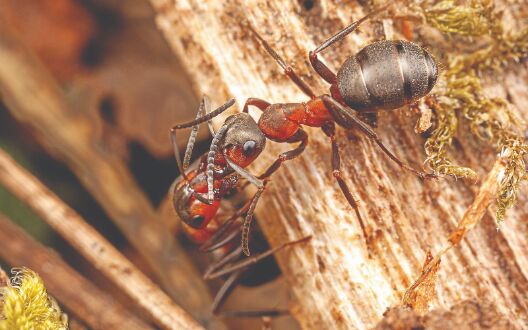Wisdom of nature
Though a relatively new buzzword for the human population, social distancing is nevertheless an old phenomenon in nature with many species using it for disease control

Social distancing is not a novel concept in the natural world. Social distancing has become one of the buzz phrases of the year but it turns out humans are not the only animals that put some space between themselves and others to reduce the transmission of disease. Certain animals use very general behavioural cues to assess potential infections and avoid certain individuals. Also, living animals have evolved fairly complex cues to induce social distancing. Through specialised senses, animals can detect certain diseases — sometimes before visible symptoms appear — and change their behaviour to avoid getting ill. Honeybees and chimpanzees, enforce strict measures to prevent the spread of disease. Bacterial diseases that strike honeybee colonies, like American foulbrood, are particularly devastating, liquifying honeybee larvae from the inside. Infected larvae emit certain telltale chemicals that older bees can smell, like oleic acid and β-ocimene, a bee pheromone. Once identified, the bees will physically toss these diseased members from the hive.
Female house mice can determine if potential partners are infected with disease via a good whiff. If the female mouse smells a parasitic infection in the male's urine, she will likely move along to other, healthier mates.
The practice of "quarantining" comes from social insects like ants and bees. In some cases, infected insects purposefully leave the colony to go off and die for the protection of its larger family. Researchers have confirmed this social behaviour by medicating infecting individuals to remove the parasites and then observed changes in avoidance behaviour. After being infection-free, they began being groomed again.
The above discussion clearly reveals that living animals constantly make decisions that affect their social lives. Individuals modify their social contact and social relationships based on adverse conditions. Such behavioural plasticity not only mediates an individual's own survival and reproduction but also alters its overarching social network, thereby influencing the dynamics of information and pathogen within the group. However, social contact among individuals, that is crucial for establishing and reinforcing social bonds, also risks contagion. These costs and benefits of social transmission lead to an evolutionary trade-off — although social relationships favour the transmission of social information, they also favour the spread of socially acquired pathogens. The transmission depends on the number and strength of social interactions (i.e., simple contagion) and/or on the occurrence of individuals in tight clusters, but the proportion of interacting partners expressing the behaviour (i.e., complex contagion) is also relevant.
Researchers have also done great studies in ants about their social behavioural response colonies during fungal infection. When a pathogen enters colony of ants, ants quickly detect the presence of a pathogen (fungal spore) and change their behaviour to strengthen already existing defences, including adaptations to their social organization for containing the spread of disease and protect the queen, brood and young workers from becoming ill. Ants do not interact randomly with other colony members but are organised in sub-groups according to their age and the tasks they carry out. The ants' subdivision into groups acts prophylactically and reduces the risk that disease spreads.
10 per cent of the worker ants (all foragers) were then exposed to fungal spores which spread easily through contact. The ants change how they interact and who they interact with. The cliques among ants become even stronger, and contact between cliques is reduced. Foragers interact more with foragers, and nurses more with nurses. This is a response by the whole colony. Also, animals who are not themselves treated with spores change their behaviour.
The colony always protects valuable individuals. The queen, the only individual that reproduces, and the nurses, young worker ants that can still contribute many hours of work to the colony, received less of the pathogen. Ants with a high predicted spore load were more likely to die nine days after exposure than ants with a low predicted spore load. Mortality was higher among foragers than among nurses. And all the queens are safe. If we critically appraise changes in behaviour that are consistent with the avoidance of the pathogen, that's pretty strong evidence that those animals are responding to the fungus itself.
The way ants collectively deal with problems, such as the risk of an epidemic, may give insights into general principles of disease dynamics. Social interactions are the routes on which diseases travel and define how epidemics may spread. Social behaviour of ants during pathogen infection can help us to deeper understand epidemiological processes, which can be relevant also in other social groups.
The researchers propose a new classification of avoidance behaviour according to the epidemiology of infection risk, where animals must avoid (i) conspecifics; (ii) parasites and their vectors; (iii) parasite-rich environments, and (iv) niche infestation.
The writer is a former Senior Scientist, Central Pollution Control Board. Views expressed are personal



